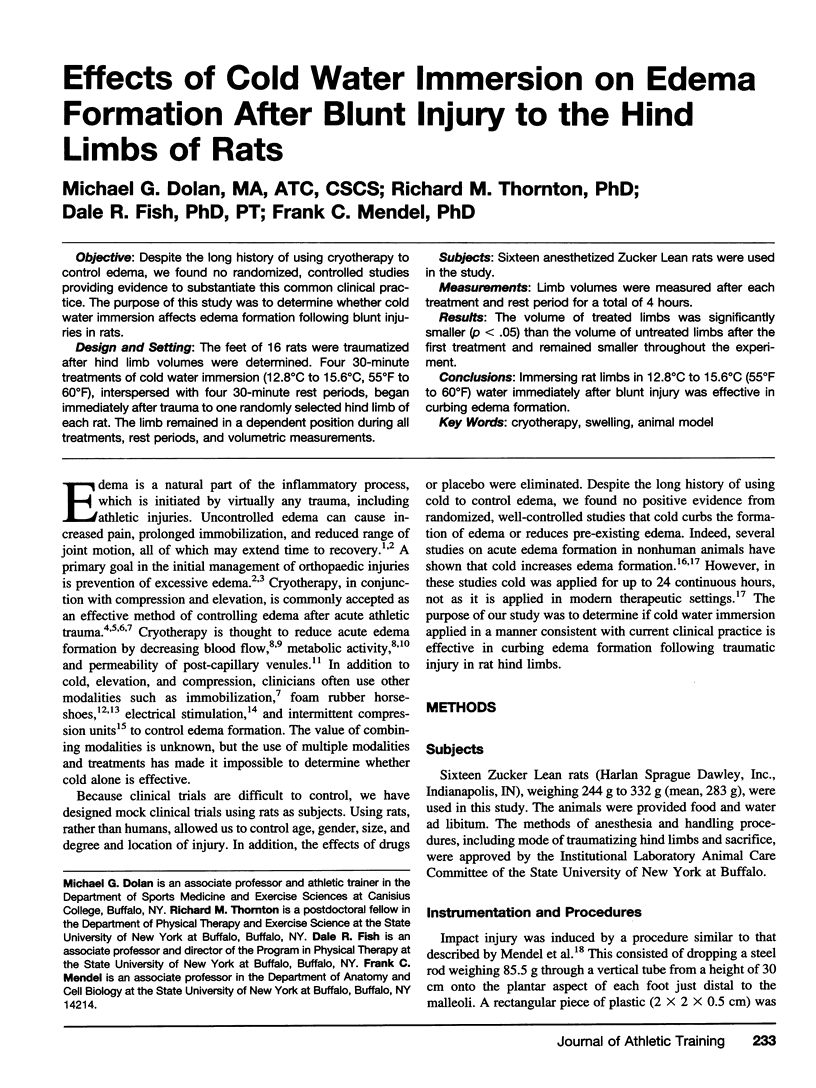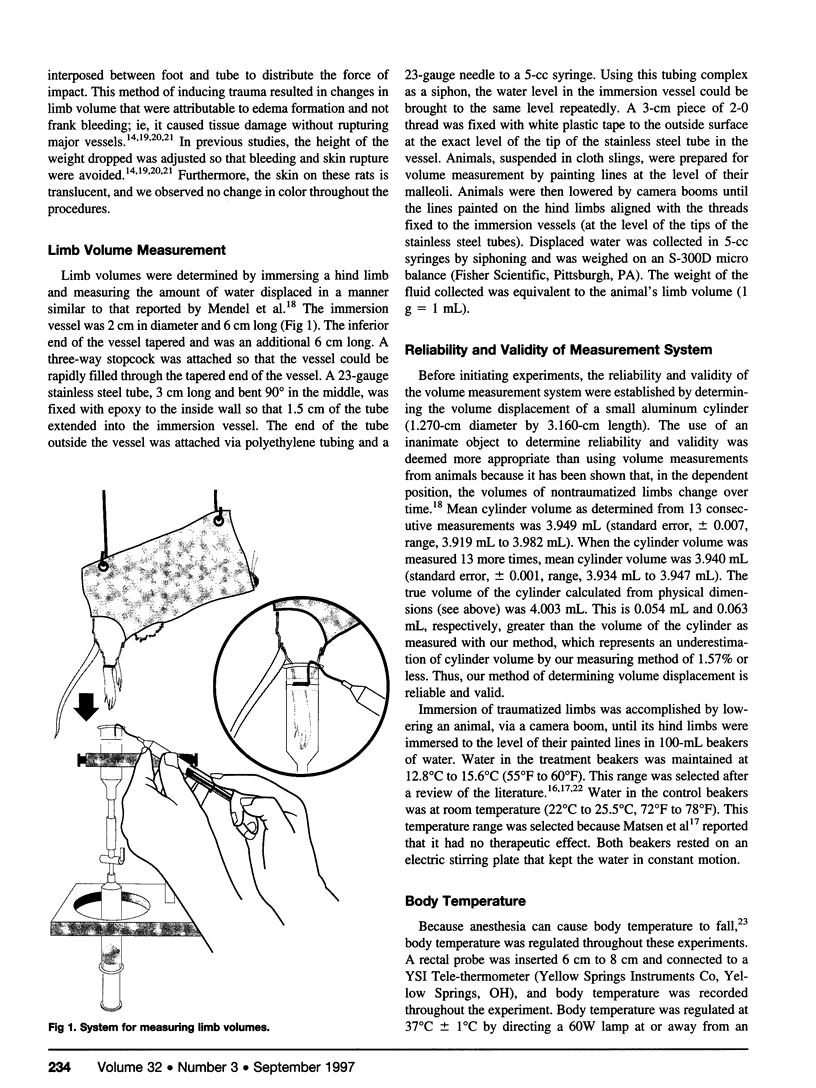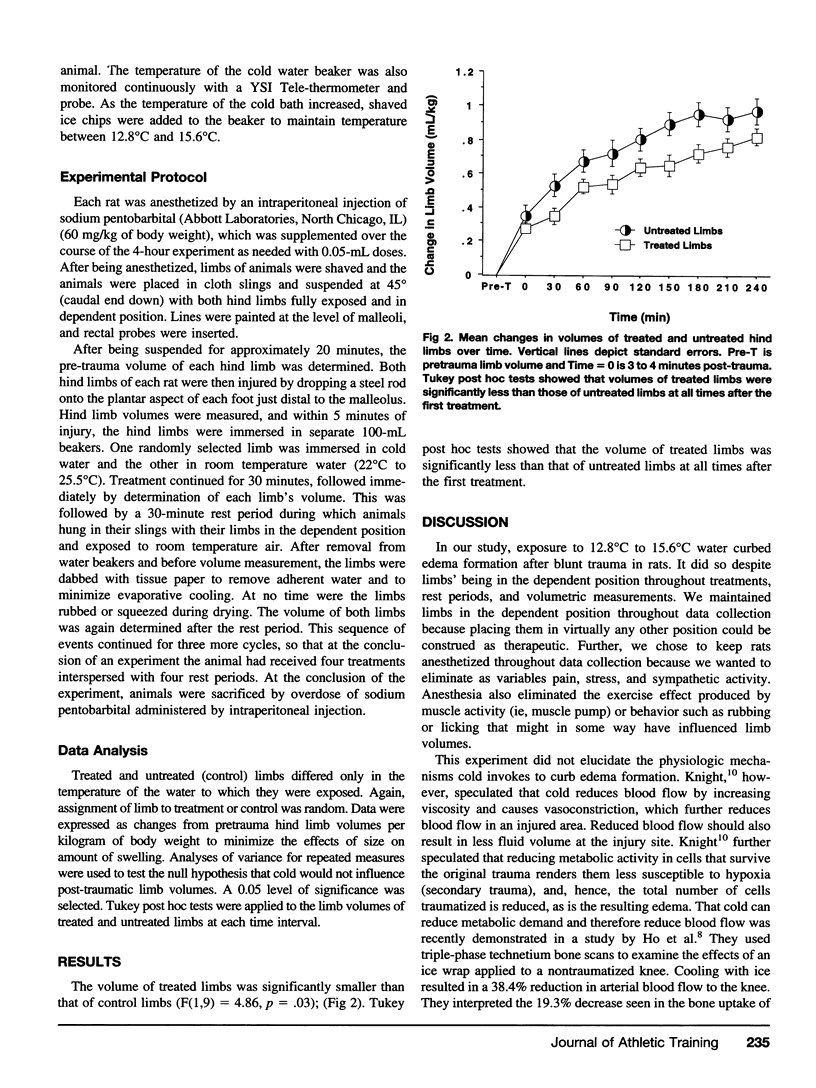Abstract
Objective:
Despite the long history of using cryotherapy to control edema, we found no randomized, controlled studies providing evidence to substantiate this common clinical practice. The purpose of this study was to determine whether cold water immersion affects edema formation following blunt injuries in rats.
Design and Setting:
The feet of 16 rats were traumatized after hind limb volumes were determined. Four 30-minute treatments of cold water immersion (12.8°C to 15.6°C, 55°F to 60°F), interspersed with four 30-minute rest periods, began immediately after trauma to one randomly selected hind limb of each rat. The limb remained in a dependent position during all treatments, rest periods, and volumetric measurements.
Subjects:
Sixteen anesthetized Zucker Lean rats were used in the study.
Measurements:
Limb volumes were measured after each treatment and rest period for a total of 4 hours.
Results:
The volume of treated limbs was significantly smaller (p < .05) than the volume of untreated limbs after the first treatment and remained smaller throughout the experiment.
Conclusions:
Immersing rat limbs in 12.8°C to 15.6°C (55°F to60°F) water immediately after blunt injury was effective in curbing edema formation.
Keywords: cryotherapy, swelling, animal model
Full text
PDF




Images in this article
Selected References
These references are in PubMed. This may not be the complete list of references from this article.
- Basur R. L., Shephard E., Mouzas G. L. A cooling method in the treatment of ankle sprains. Practitioner. 1976 Jun;216(1296):708–711. [PubMed] [Google Scholar]
- Bettany J. A., Fish D. R., Mendel F. C. Influence of high voltage pulsed direct current on edema formation following impact injury. Phys Ther. 1990 Apr;70(4):219–224. doi: 10.1093/ptj/70.4.219. [DOI] [PubMed] [Google Scholar]
- Coté D. J., Prentice W. E., Jr, Hooker D. N., Shields E. W. Comparison of three treatment procedures for minimizing ankle sprain swelling. Phys Ther. 1988 Jul;68(7):1072–1076. doi: 10.1093/ptj/68.7.1072. [DOI] [PubMed] [Google Scholar]
- Farry P. J., Prentice N. G., Hunter A. C., Wakelin C. A. Ice treatment of injured ligaments: an experimental model. N Z Med J. 1980 Jan 9;91(651):12–14. [PubMed] [Google Scholar]
- Ho S. S., Coel M. N., Kagawa R., Richardson A. B. The effects of ice on blood flow and bone metabolism in knees. Am J Sports Med. 1994 Jul-Aug;22(4):537–540. doi: 10.1177/036354659402200417. [DOI] [PubMed] [Google Scholar]
- Hocutt J. E., Jr, Jaffe R., Rylander C. R., Beebe J. K. Cryotherapy in ankle sprains. Am J Sports Med. 1982 Sep-Oct;10(5):316–319. doi: 10.1177/036354658201000512. [DOI] [PubMed] [Google Scholar]
- Knight K. L., Londeree B. R. Comparison of blood flow in the ankle of uninjured subjects during therapeutic applications of heat, cold, and exercise. Med Sci Sports Exerc. 1980 Spring;12(1):76–80. doi: 10.1249/00005768-198021000-00015. [DOI] [PubMed] [Google Scholar]
- Matsen F. A., 3rd, Questad K., Matsen A. L. The effect of local cooling on postfracture swelling. A controlled study. Clin Orthop Relat Res. 1975;(109):201–206. doi: 10.1097/00003086-197506000-00029. [DOI] [PubMed] [Google Scholar]
- McMaster W. C. A literary review on ice therapy in injuries. Am J Sports Med. 1977 May-Jun;5(3):124–126. doi: 10.1177/036354657700500305. [DOI] [PubMed] [Google Scholar]
- McMaster W. C., Liddle S. Cryotherapy influence on posttraumatic limb edema. Clin Orthop Relat Res. 1980 Jul-Aug;(150):283–287. [PubMed] [Google Scholar]
- McMaster W. C., Liddle S., Waugh T. R. Laboratory evaluation of various cold therapy modalities. Am J Sports Med. 1978 Sep-Oct;6(5):291–294. doi: 10.1177/036354657800600513. [DOI] [PubMed] [Google Scholar]
- Meeusen R., Lievens P. The use of cryotherapy in sports injuries. Sports Med. 1986 Nov-Dec;3(6):398–414. doi: 10.2165/00007256-198603060-00002. [DOI] [PubMed] [Google Scholar]
- Mendel F. C., Fish D. R. New Perspectives in Edema Control via Electrical Stimulation. J Athl Train. 1993 Spring;28(1):63–74. [PMC free article] [PubMed] [Google Scholar]
- Mendel F. C., Wylegala J. A., Fish D. R. Influence of high voltage pulsed current on edema formation following impact injury in rats. Phys Ther. 1992 Sep;72(9):668–673. doi: 10.1093/ptj/72.9.668. [DOI] [PubMed] [Google Scholar]
- Rippe B., Grega G. J. Effects of isoprenaline and cooling on histamine induced changes of capillary permeability in the rat hindquarter vascular bed. Acta Physiol Scand. 1978 Jul;103(3):252–262. doi: 10.1111/j.1748-1716.1978.tb06212.x. [DOI] [PubMed] [Google Scholar]
- Sloan J. P., Hain R., Pownall R. Clinical benefits of early cold therapy in accident and emergency following ankle sprain. Arch Emerg Med. 1989 Mar;6(1):1–6. doi: 10.1136/emj.6.1.1. [DOI] [PMC free article] [PubMed] [Google Scholar]
- Taylor K., Fish D. R., Mendel F. C., Burton H. W. Effect of a single 30-minute treatment of high voltage pulsed current on edema formation in frog hind limbs. Phys Ther. 1992 Jan;72(1):63–68. doi: 10.1093/ptj/72.1.63. [DOI] [PubMed] [Google Scholar]



